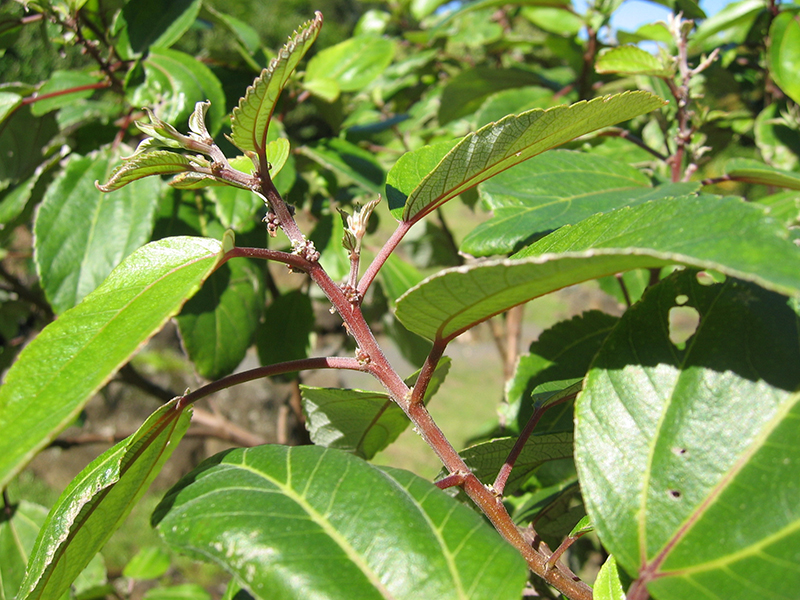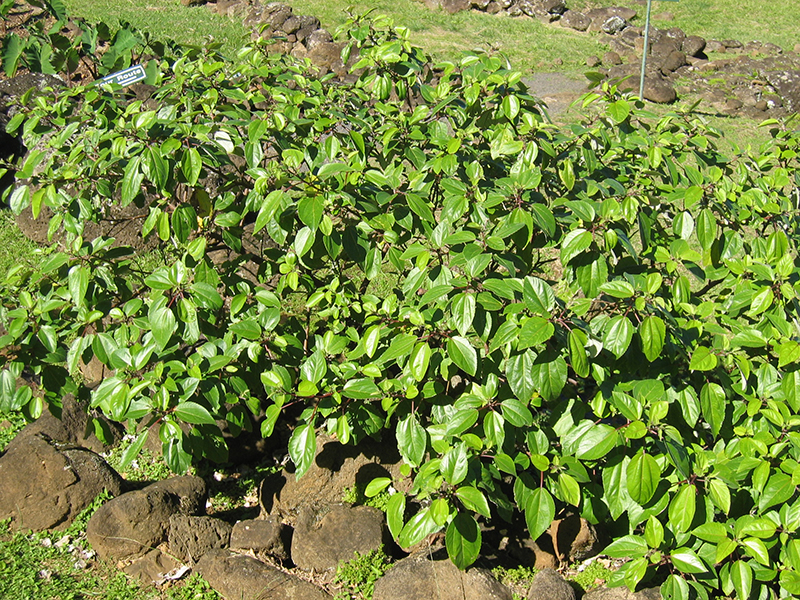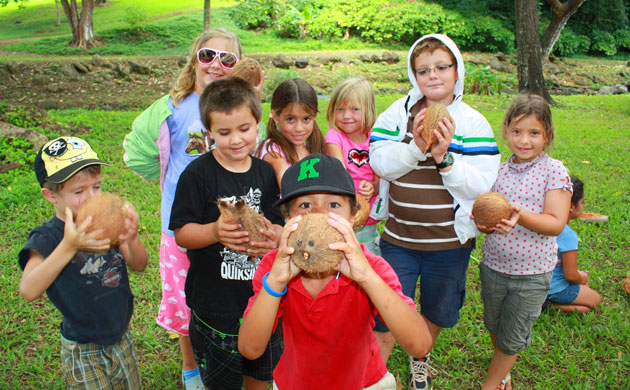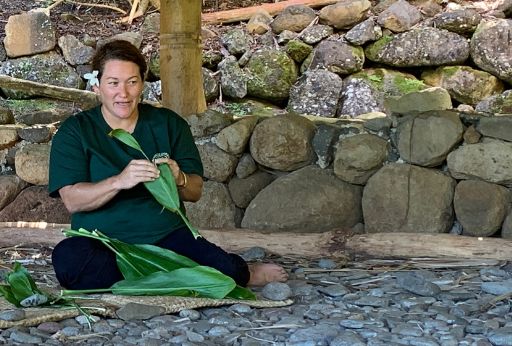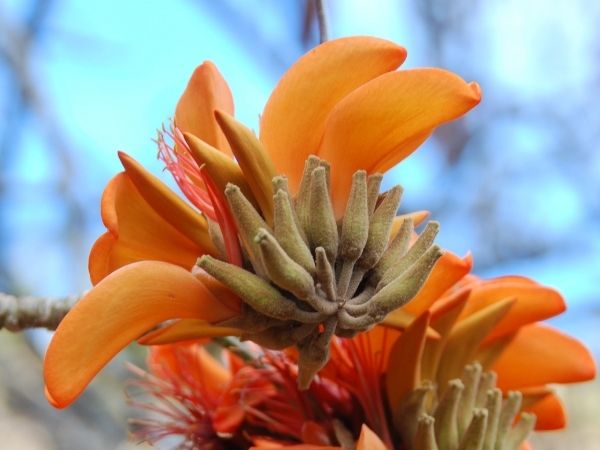Tropical Plant Database - Plant Details
Pipturus kauaiensis
Click on any heading above to view more information about this plant
Conservation Status
- IUCN: endangered
- USFWS: None
Family: URTICACEAE
Genus: Pipturus
Species: kauaiensis
Species Author: A. Heller
Vernacular: Mamaki, Mamake
Synonyms: Pipturus albidus var. grosseserrata
Genus: Pipturus
Species: kauaiensis
Species Author: A. Heller
Vernacular: Mamaki, Mamake
Synonyms: Pipturus albidus var. grosseserrata
Pipturus kauaiensis is a perennial shrub that grows from 1.5 to 3 m tall. The leaves are 6-18.5 cm long and 2-6.5 cm wide with toothed margins and alternately arranged along the branches. Both the branches and leaves of Māmaki are covered with distinctive white hairs. The hairs are often visible on new leaves and the lower leaf surface can be completely obscured by short woolly hairs. Māmaki flowers develop in clusters in the leaf axils (between the base of the petiole that supports the blade of the leaf and the stem) which gives this plant a very distinctive appearance when it is flowering. Plants can produce either pistillate flowers (producing only female structures) or perfect flowers (producing both male and female structures). The clusters of flowers are only 3-4 mm in diameter and the individual flowers are even smaller (1-2.4 mm long). The fruit is also small (0.9-1.0 mm long), dry, and single seeded however the base of the flower persists and becomes fleshy during fruit formation surrounding the dry fruit with fleshy white tissue.
(Wagner, W. L., Herbst, D. R., and S. H. Sohmer. 1999. Manual of the Flowering Plants of Hawai`i. Revised Edition. Volume 2. Bishop Museum Special Publication 97. University of Hawai`i Press, Bishop Museum Press, Honolulu, Hawai`i.)
(Wagner, W. L., Herbst, D. R., and S. H. Sohmer. 1999. Manual of the Flowering Plants of Hawai`i. Revised Edition. Volume 2. Bishop Museum Special Publication 97. University of Hawai`i Press, Bishop Museum Press, Honolulu, Hawai`i.)
Māmaki leaves are considered to act as a general tonic and tea made from steeping the leaves in hot water is taken for general health and wellbeing.
(Abbott, I A. 1992. Lā`au Hawii`i: Traditional Hawaiian Uses of Plants. Bishop Museum Press, Honolulu, Hawai`i.)
(Abbott, I A. 1992. Lā`au Hawii`i: Traditional Hawaiian Uses of Plants. Bishop Museum Press, Honolulu, Hawai`i.)
Māmaki species were traditionally utilized to make kapa as an alternative to the more commonly utilized species Wauke (Broussonetia papyrifera). Many more branches were needed to provide enough fiber for the production of kapa from māmaki than from wauke however it produced very good quality kapa and was highly valued. Kapa that is produced from māmaki is naturally brown in color and may be further colored by the application of oil obtained from the Kukui (Aleurites moluccana) fruit.
(Abbott, I A. 1992. Lā`au Hawii`i: Traditional Hawaiian Uses of Plants. Bishop Museum Press, Honolulu, Hawai`i.)
(Abbott, I A. 1992. Lā`au Hawii`i: Traditional Hawaiian Uses of Plants. Bishop Museum Press, Honolulu, Hawai`i.)
Pipturus kauaiensis is endemic to Kaua`i, meaning this is the only place where this species is found. It occurs in mesic forest ranging in elevation from 60 to 1280 m. There are three other species in this genus in Hawai`i. The most common species is P. albidus which is found extensively throughout the Hawaiian archipelago. The genus Pipturus is found throughout the Pacific including species in Australia, Melesia, and the Mascarene Islands.
(Mabberley, D. J., 1997. The Plant-Book: A portable dictionary of the vascular plants. Second edition. Cambridge University Press, Cambridge, England.)
(Wagner, W. L., Herbst, D. R., and S. H. Sohmer. 1999. Manual of the Flowering Plants of Hawai`i. Revised Edition. Volume 2. Bishop Museum Special Publication 97. University of Hawai`i Press, Bishop Museum Press, Honolulu, Hawai`i.)
(Mabberley, D. J., 1997. The Plant-Book: A portable dictionary of the vascular plants. Second edition. Cambridge University Press, Cambridge, England.)
(Wagner, W. L., Herbst, D. R., and S. H. Sohmer. 1999. Manual of the Flowering Plants of Hawai`i. Revised Edition. Volume 2. Bishop Museum Special Publication 97. University of Hawai`i Press, Bishop Museum Press, Honolulu, Hawai`i.)
A closely related and widespread Hawaii species, Pipturus albidus, is a host species for the endemic Hawaiian long-horned cerambycid beetles in the genus Plagithmysus. Other host plants for these beetles includ Koa, Alani, Ohi`a, and Mamane. The female beetle lays the eggs on the branches or stems of dead or dying trees and when the larvae hatch they bore into the bark to feed leaving tell-tale trails in the wood. The larvae excavate a cell in the wood of the tree to pupate and once again bore their way out of the wood when they emerge as adults.
(Gressitt, J.L. 1980. The Hawaiian Ceramycid Beetles. Proceedings of the Third Conference in Nat. Sci. Hawaii Volcanoes Nat. Park.)
(Gressitt, J.L. 1980. The Hawaiian Ceramycid Beetles. Proceedings of the Third Conference in Nat. Sci. Hawaii Volcanoes Nat. Park.)
- 033343 - collected by C. N. Forbes in 1909
- 079277 - collected by Derral Herbst in 1973
- S078745 - collected by David H. Lorence in 1987
- 020566 - collected by David H. Lorence in 1987
- 020567 - collected by David H. Lorence in 1987
- 020568 - collected by Tim Flynn in 1987
- 020569 - collected by David H. Lorence in 1988
- 008673 - collected by David H. Lorence in 1988
- 008761 - collected by K. R. Wood in 1988
- 008653 - collected by K. R. Wood in 1989
- 009483 - collected by K. R. Wood in 1991
- 011068 - collected by K. R. Wood in 1991
- 012952 - collected by K. R. Wood in 1992
- 029259 - collected by K. R. Wood in 1994
- Unassigned - collected by K. R. Wood in 1996
- 029345 - collected by K. R. Wood in 1996
- 051836 - collected by K. R. Wood in 1996
- 044185 - collected by K. R. Wood in 1998
- 043256 - collected by Natalia Tangalin in 2004
- 055010 - collected by K. R. Wood in 2005
- 063517 - collected by Natalia Tangalin in 2005
- 063518 - collected by Natalia Tangalin in 2005
- 058476 - collected by Natalia Tangalin in 2005
- 060344 - collected by Natalia Tangalin in 2005
- 055857 - collected by Natalia Tangalin in 2007
- 069740 - collected by Natalia Tangalin in 2011
- 060264 - collected by Natalia Tangalin in 2012
- 060677 - collected by Natalia Tangalin in 2012
- 076232 - collected by Natalia Tangalin in 2012
- 065645 - collected by David H. Lorence in 2012
- 076285 - collected by K. R. Wood in 2017
- 076365 - collected by Uma Nagendra in 2017
- 083433 - collected by K. R. Wood in 2021
- 083438 - collected by K. R. Wood in 2021
- 087375 - collected by K. R. Wood in 2021
- Unassigned - collected by K. R. Wood in 2022
- 094181 - collected by Frances Caflisch in 2024
- Unassigned - collected by Frances Caflisch in 2024
- 095688 - collected by Uma Nagendra in 2024
We currently have 39 herbarium specimens for Pipturus kauaiensis in our collection. Click on any specimen below to view the herbarium sheet data.
.svg)
